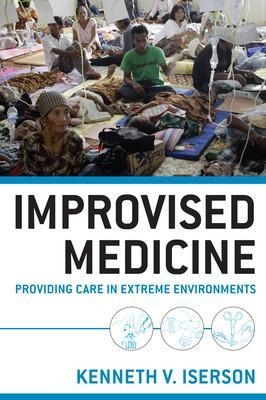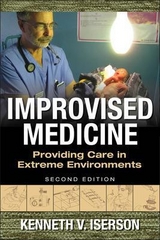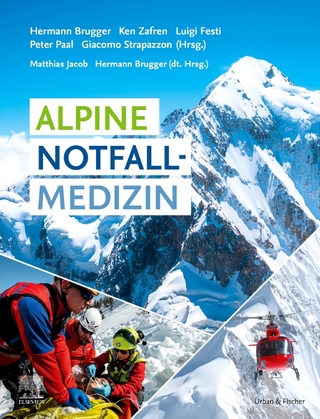
Improvised Medicine: Providing Care in Extreme Environments
McGraw-Hill Medical (Verlag)
978-0-07-175497-2 (ISBN)
- Titel z.Zt. nicht lieferbar
- Versandkostenfrei innerhalb Deutschlands
- Auch auf Rechnung
- Verfügbarkeit in der Filiale vor Ort prüfen
- Artikel merken
Publisher's Note: Products purchased from Third Party sellers are not guaranteed by the publisher for quality, authenticity, or access to any online entitlements included with the product.
Deliver quality healthcare in the most challenging field conditions
"Dr Iserson has given us a most remarkable book. Many readers may be familiar with David Werner's lay healthworker book, Where There Is No Doctor; this new volume could be titled Where There Is a Doctor–But No Stuff. Drawing from his experience providing care in international, wilderness, and disaster settings, he has compiled an impressive collection of bare-bones equipment and work-around strategies to provide the best possible care in resource-poor settings. While presenting many creative examples, the purpose of the book is not to offer an exhaustive list of solutions to missing resource challenges but to inspire creativity in readers who may find themselves needing to improvise." -- Family Medicine
Full of practical clinical pearls and proven strategies, this indispensible guide shows you how to operate outside your comfort zone and devise effective treatment solutions when the traditional tools (medications, equipment, and staff) are unavailable—or when you need to provide care outside of your specialty. Improvised Medicine is a must for anyone who plans to work in global, disaster, or other resource-poor settings.
FEATURES:
Simple-to-follow directions, diagrams, and illustrations describe practical techniques and the improvised equipment necessary to provide quality care during crises.
Contains improvisations in anesthesia and airway management, dentistry, gynecology/obstetrics, infectious disease/laboratory diagnosis, internal medicine, otolaryngology, pediatrics and malnutrition, orthopedics, psychiatry, and surgery.
Also includes basic disaster communication techniques, post-disaster forensics, a model hospital disaster plan, and innovative patient-transport methods.
LEARN HOW TO:
Make an endotracheal tube in seconds
Perform digital-oral and blind-nasotracheal intubations
Make plaster bandages for splints/casts
Give open-drop ether, ketamine drips, and halothane
Use subcutaneous/intraperitoneal rehydration/transfusion
Make ORS and standard nutrition formulas
Clean, disinfect, and sterilize equipment for reuse
Warm blood units in seconds inexpensively
Take/view stereoscopic x-rays with standard equipment
Quickly and easily stop postpartum hemorrhage
Fashion surgical equipment from common items
Evacuate patients easily for high-rise hospitals
Make esophageal and precordial stethoscopes
Quickly improvise a saline lock
Make ECG electrode/defibrillator pads and ultrasound gel
Kenneth V. Iserson, MD, MBA, FACEP, FAAEM Fellow, International Federation of Emergency Medicine Professor Emeritus, Emergency Medicine The University of Arizona Tucson, AZ Founder/Director, REEME (www.reeme.arizona.edu)
Section I. The Situation
1: What is Improvised Medicine?
2: What Are Resource-Poor Situations?
Section II. Basic Needs
3: Communication
4: Preventive Medicine/Public Health
5: Basic Equipment
6: Cleaning and Reusing Equipment
Section III: Patient Assessment/Stabilization
7: Vital Signs and Triage
8: Airway
9: Breathing/Pulmonary
10: Circulation/Cardiovascular
11: Dehydration/Rehydration
12: Medications/Pharmacy/Envenomations
13: Analgesics
14: Anesthesia—Local and Regional
15: Sedation and General Anesthesia
16: Anesthesia: Ketamine, Ether and Halothane
17: Transfusion
18: Radiology/Imaging
19: Laboratory
20: Patient Transport/Evacuations
Section IV: Surgical Interventions
21: Surgery/Trauma
22: Wounds and Burns
23: Dental Diagnosis, Equipment, Blocks and Treatment
24: Dental: Fillings, Extractions and Trauma
25: Otolaryngology (ENT)
26: Neurology/Neurosurgery
27: Ophthalmology
28: Obstetrics/Gynecology
29: Orthopedics
30: Urology
Section V: Non-Surgical Interventions
31: Gastroenterology
32: Infectious Diseases
33: Malnutrition
34: Pediatrics and Neonatal
35: Psychiatry
36: Rehabilitation
37: Death and Survivors
Section VI: Appendices
Appendix 1: Hospital Disaster Plan
Appendix 2: Medical Kits
| Erscheint lt. Verlag | 16.3.2012 |
|---|---|
| Zusatzinfo | 300 Illustrations |
| Verlagsort | New York |
| Sprache | englisch |
| Maße | 152 x 229 mm |
| Gewicht | 678 g |
| Themenwelt | Medizin / Pharmazie ► Allgemeines / Lexika |
| Medizin / Pharmazie ► Gesundheitswesen | |
| Medizin / Pharmazie ► Medizinische Fachgebiete ► Notfallmedizin | |
| ISBN-10 | 0-07-175497-0 / 0071754970 |
| ISBN-13 | 978-0-07-175497-2 / 9780071754972 |
| Zustand | Neuware |
| Informationen gemäß Produktsicherheitsverordnung (GPSR) | |
| Haben Sie eine Frage zum Produkt? |
aus dem Bereich



